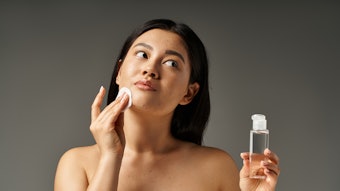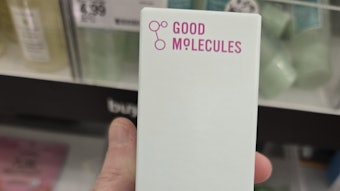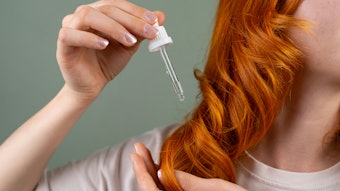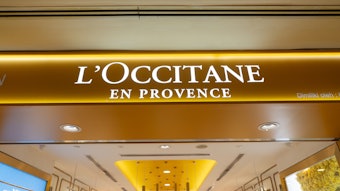Facial shaving is primarily a men’s ritual that may have unexpected skin benefits. Razors are one of the best ways to physically exfoliate surface skin cells and remove impurities from open blackheads. Conversely, improper shaving obviously can lead to irritation, removal of excessive skin layers, small cuts and pseudofolliculitis, i.e., ingrown hairs. Improperly shaved facial skin may also incur reddening, inflammation, telangiectasia or spider veins, pimples and post-inflammatory hyperpigmentation. Electric shavers induce different skin disequilibrium effects. Their vibrational energy can increase the local skin temperature, damaging small capillary blood vessels and increasing inflammation. In contrast, razor shaving has a more superficial impact, although its peeling action in the presence of alkaline shaving soaps could be too harsh for delicate skin.
For these reasons, consumers often turn to specially formulated shaving creams and aftershaves to maintain healthy skin. Such products could be differentiated based on the type of shaving instrument used, although with either, TEWL values for facial skin increase noticeably. This column will discuss how to approach formulating aftershaves.
In theory, aftershaves are applied to the shaved face to counteract skin irritation induced by shaving. This was especially true and necessary with the razors and electric shavers of the past, which were less refined and harsher on skin. Aftershave also allows those who prefer not to use cologne to wear a slight scent. Since shaving is a normal practice in daily hygiene for most men, it has been used by the cosmetic industry to expand the male grooming market—and today’s aftershaves have transformed into skin care treatments for the male face.
Male vs. Female Skin
Male skin is unique as it is subject to a testosterone influx, which influences sebum production. This higher sebum secretion maintains skin moisture. Therefore, men need moisturizers less frequently than women. Also in men, each facial hair is accompanied by a large pilosebaceous follicular unit that extends deeply in the dermis. Such a follicular unit accompanies the thin and transparent facial hair in women, but is much smaller. This results in thicker skin in men, compared with women, which opposes the penetration of UVA rays more efficiently and thus experiences less collagen fiber degradation—in turn, making men’s skin more resistant to photoaging and wrinkles than women’s. Therefore, men need fewer skin care products than women; however, the presence of larger follicular units in the beard areas of the face necessitates its own special personal care products.
Formulation
Besides soothing and calming irritated skin, aftershaves are expected by consumers to have additional functions, including: freshening effects, emolliency, reducing blood flow, toning skin, imparting scent, antibacterial benefits and preventing folliculitis. Optional effects might include anti-wrinkle and skin lightening. The formulator should be cognizant that aftershave is applied on freshly shaved skin, which maximizes the absorption of ingredients and, consequently, related toxicological risks—i.e., allergy, irritation and systemic absorption. Therefore, sunscreens and excess emulsifiers in general, or ingredients that increase superficial bloodflow or are common allergens, should not be incorporated.
Also, fragrance in modern aftershaves must initially be intense, but mostly disappear quickly. Most men enjoy the sensory effects of a scented aftershave but do not want that scent to linger. Colors may be added to the formula as well, to support the sensorial impact of other ingredients.
There primarily are three categories of aftershave formulations: fluid transparent solutions (splash-on), thick gels, and fluid emulsion lotions. It is rare to find aerosol or spray pump products, since aftershaves are applied near the eyes. In addition, application by hand often is preferred.
Transparent Solutions
In general, most aftershaves are hydro-alcoholic solutions, with an alcohol content high enough to provide quick evaporation from the face and a cooling sensation. Alcohol also eliminates the need for preservatives while at the same time reducing the bacterial charge on the face. Further, it allows for the addition of lipid-soluble soothing ingredients, such as vitamin E, glycyrrhetinic acid or vegetal oils, by increasing their solubility, without the need for excessive amounts of surfactants. Finally, the right alcohol content aids the dissolution of the formula’s fragrance.
Allantoin: Many hydrosoluble ingredients are added to transparent aftershave solutions, the most common being allantoin. Allantoin helps to heal small cuts, speed skin regeneration, and is a well-known skin soother, all at a relatively low cost. However, it has limited solubility in water (0.57%), which is dramatically decreased by the addition of ethanol (0.2% max solubility) and glycerin (0.15% max solubility). Its solubility is also strongly temperature-dependent; at cold temperatures, allantoin forms a white precipitate with sharp-needled crystals that can sting the skin. Since allantoin imparts many advantages, though, the addition of 2% betaine can increase its solubility in water, improving its application in aftershaves.
Organic acids: The toning action in transparent solution aftershaves is provided by organic acids, usually lactic or citric, that give an immediate astringent effect. Additionally, salicylic acid is said to reduce razor bumps, since it performs a keratolytic action. Also, a soothing action can be obtained with hydrolyzed silk proteins.
Menthol derivatives: Besides the cooling effect given by the evaporation of alcohol, menthol derivatives such as menthyl pyrrolidone carboxylate, mentyl lactate, menthone glycerin acetal, etc., are frequently added for a longer-lasting refreshing action. These derivatives currently are preferred to simple menthol, which is a potential allergen. Traces of camphor, i.e., < 0.01%, have also been used for a balsamic sensation.
Hydrotropes: A simple hydro-alcoholic vehicle can effectively degrease skin, too, so hydrotropes are added, such as glycols, glycerin or sorbitol. The relative amounts of the water/alcohol/hydrotrope trifecta can be tailored according to the evaporation time required, the climate in a specific region, the required final skin feel, and the presence of other additives that must be easily soluble in the prepared vehicle.
Preservatives and glycols: As stated, preservatives are not usually added in hydro-alcoholic solutions, unless a completely alcohol-free aftershave is desired. In this case, cooling can be guaranteed by the menthol derivatives while the vehicle should have good capability to dissolve ingredients that require an organic solvent, such as complex glycols.
Solubilizers: Fragrances usually do not require additional solubilizers unless very low alcohol concentration is used in their formula. If they are required, long chain ethoxylated triglycerides or specialized solubilizing blends are used.
Aesthetics: In general, a small amount (≤ 0.3-0.5%) of hydrophilic polymer could be added to aftershaves to provide a special residual feel. PVP has been used in the past but more modern hydrophilic polymers are now available. Such film-formers also support the healing action of the formula and maintain a fair amount of active principles on the skin. Colors are generally added to increase the aesthetic appeal of transparent formulae, and UV absorbers and chelating agents may be included to increase the light-fastness of the shade to avoid discoloration, since aftershave is often packaged in transparent bottles.
Formula 1 represents a simple transparent aftershave solution. Besides vegetal extracts, additives may include vitamins, bisabolol, osmotic protectants, UV filters, quaternary conditioners, etc. In this example, carbomer is dispersed into the alcohol to avoid the formation of lumps during swelling. Due to the high level of alcohol, this formula does not contain preservatives. The other variables in this formula are: the alcohol/water ratio, the type and amount of thickener, the neutralizing agent and the sequestering agent.
In industrial preparation, all the liposoluble ingredients such as fragrance are dissolved in alcohol—in anti-explosive equipment—to which the solution containing the water-soluble ingredients and hydrotropes is slowly added. Propeller mixing is usually adopted to obtain a whirling motion without releasing excessive energy to the fluid. Note that the reverse, i.e., adding the alcohol solution to the water, could induce insolubilities and precipitate some ingredients. Filtration is not usually necessary, unless vegetal extracts or natural derived perfumes with high residue are used.
Another vintage, but still valid, example of a conditioning and anti-irritant aftershave lotion is shown in Formula 2, which described the use of sodium lactate as a moisturizer and niacinamide as a skin strengthener.1
Thick Gels
The criteria for formulating transparent aftershave gels are the same as for hydro-alcoholic solutions with one exception: additional thickening to obtain a smooth gel. This is shown in Formula 3, which is similar to Formula 1 but with an increased amount of thickener. Most transparent thickeners could be used, such as hydroxyethyl or hydroxypropyl cellulose, as seen in Formula 3, or some grades of xanthan gum. Taurate copolymers can be used, even with low alcohol content, and some acrylate copolymers or crosspolymers, too. Note that thickening a formula will also tune the evaporation of its vehicle, reducing the impact of alcohol on the skin, and allowing for a more delicate skin treatment—although the residual skin feel of the polymer film after the solvents have evaporated must be light and non-sticky.
Regarding production, the thickening agent must be dispersed and swelled well before the addition of alcohol, if it is present in the formula. This is usually accomplished in the water phase but inverse addition into the alcohol is possible if the dispersing equipment is explosion-proof. Hydrotropes such as glycerin can be used to more easily pre-disperse and swell the polymer. Alcohol-free gel formulations also can be prepared. These adopt only water-soluble actives or use solubilizers. In these cases, special glycols having good compatibility with oil phases, such as isopentyldiol or diglycerol, are suggested.
Fluid Emulsions
Fluid emulsion-type aftershaves generally have low amounts of oil phase. Oils are quickly absorbed by the skin, without leaving any visible trace. To obtain a skin-friendly treatment, polymeric emulsifiers are generally preferred to monomeric types because they have a much lower skin irritation potential. For fulid emulsions, all the actives described previously could be used, with an added advantage that some lipophilic ingredients can be dissolved in the oil phase. Emulsions provide a more nourishing effect on skin than hydro-alcoholic solutions; therefore, they are more suitable for anti-aging skin treatments.
Formula 4 shows a simple fluid emulsion aftershave.2 Here, lecithin derivatives reinforce the skin barrier and increase the penetration of the active principles. This formula is simple but has many possible variations, within the given concentration indications. For instance, the alkali could be arginine; glycerin could be substituted by trehalose or xylitol; refined shea butter or caprylyl ether could be used instead of the triglyceride; and so on. An alcohol level below 18-20% of the total water content will not sufficiently preserve the formula, so in this case, the formulator must incorporate preservatives; knowledge of microbial resistance is key when reducing alcohol content.
New Technologies
Aftershaves are usually associated with fragrance since they frequently are extensions of cologne lines. And all aftershaves promise soothing, healing, anti-irritant, moisturizing and cooling functions. However, more recent aftershaves, in emulsion lotion form, also boast revitalizing actions.
One example is L’Orèal’s Men Expert “Hydra Energetic” aftershave and multi-repairing balm, which claims to fortify skin. Another is Johnson & Johnson’s Neutrogena Men “Triple Protect Face Lotion” with an SPF 20, which is said to soothe razor irritation and provide sun protection, and moisturizing and anti-aging benefits. Also, Elizabeth Grant’s “Grant for Men” aftershave soothing serum aims to protect skin from daily environmental stress while providing anti-aging benefits; such as keeping skin soft while reducing the appearance of fine lines and wrinkles.
In the age of high performance male skin care, new actives are being offered to accelerate repair from shaving cuts, improve skin’s resilience to environmental stress, i.e., cold and heat, and provide good moisturization. Rahn launched such an activea, combining the osmotic protectant taurine with skin-strengthening Siberian ginseng extract and cell-boosting factors from algae and lupins.
In the field of cooling agents, Symrise prepared a menthyl ethylamido oxalate for an extreme sensation of freshness that is fast and long-lastingb. It is also an odorless liquid, avoiding all interference with perfume notes.
An anti-irritant more recently recommended for emulsion aftershaves is Boswellia serrata extract, which is suggested for sensitive skin. And finally, a protein material obtained by advanced biotechnology processes copies the structure of spider silkc. It has been introduced as a skin soothing anti-irritant. Available in different grades, it is reported to calm skin irritation and provide a strong moisturizing effect, while accelerating skin regeneration and leaving an invisible matte layer on the skin.
References
- US Patent 4758599, Clear, hydroalcoholic aftershave lotion which moisturizes, conditions and prevents irritation, DC Minetti, assigned to American Cyanamid Company (Jul 19, 1988)
- After Shave Balm, Rhodia Novecare Asia Pacific Pte. Ltd., Personal Care Magazine, www.personalcaremagazine.com/FormulationDetails.aspx?Formulation=190 (Accessed Oct. 2, 2014)
!['Snoopy and Woodstock are cherished [characters] across generations and pairing them with our most-loved body care essentials creates a collection that feels classic with a modern twist. This launch is about celebrating our community with something unforgettable while starting an exciting new era for the brand,' said Luis Garcia, Chief Marketing Officer.](https://img.cosmeticsandtoiletries.com/mindful/allured/workspaces/default/uploads/2025/10/tree-hut-peanuts-fullcollection-fall26-1x1-1253.lGcuurUszp.jpg?auto=format%2Ccompress&fit=crop&h=191&q=70&w=340)









